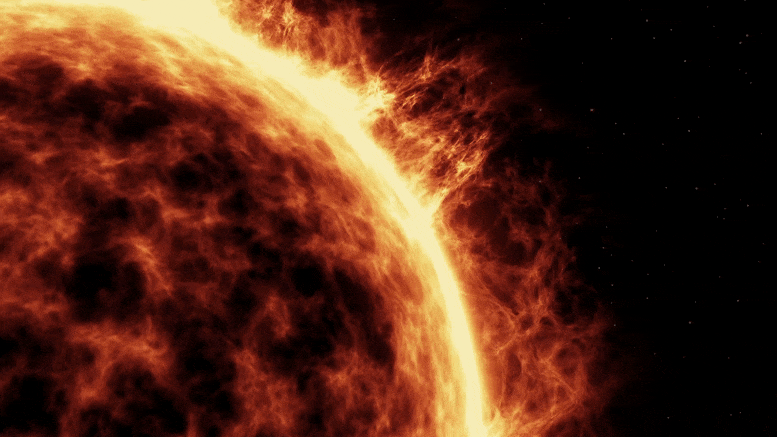
A new study using the Goode Solar Telescope at the Big Bear Solar Observatory has revealed intense wave energy from sunspots that can sustain temperatures of up to a million degrees in the sun’s corona. While this discovery advances our understanding of the problem of coronal heating of the Sun, the mystery is not yet fully solved.
with data from[{” attribute=””>Big Bear Solar Observatory’s Goode Solar Telescope, researchers discover intense wave energy in the coldest region on the Sun, the sunspot umbra, which is driving puzzling temperatures in the star’s upper atmosphere.
Nearly five thousand kilometers above the Sun’s surface lies a century-old question for solar physicists — how are temperatures in the star’s upper atmosphere, or corona, hundreds of times hotter than temperatures at the Sun’s visible surface?
An international team of scientists has a new answer to the question — commonly referred to as the Sun’s coronal heating problem — with new observational data obtained with the 1.6-meter Goode Solar Telescope (GST) at Big Bear Solar Observatory (BBSO), operated by NJIT’s Center for Solar Terrestrial Research (CSTR).
In a study published recently in the journal Nature Astronomy, researchers have unveiled the discovery of intense wave energy from a relatively cool, dark and strongly magnetized plasma region on the Sun, capable of traversing the solar atmosphere and maintaining temperatures of a million degrees Kelvin inside the corona.

Extreme ultra-violet emission by solar coronal plasma at millions of degrees. Credit: Atmospheric Imaging Assembly (AIA) on board NASA’s Solar Dynamics Observatory (SDO) spacecraft
Researchers say the finding is the latest key to unraveling a host of related mysteries pertaining to Earth’s nearest star.
“The coronal heating problem is one of the biggest mysteries in solar physics research. It has existed for nearly a century,” said Wenda Cao, BBSO director and NJIT physics professor who is co-author of the study. “With this study, we have fresh answers to this problem, which may be key to untangling many confusing questions in energy transportation and dissipation in the solar atmosphere, as well as the nature of space weather.”
Using GST’s unique imaging capabilities, the team led by Yuan Ding was able to initially capture transverse oscillations in the darkest and coldest region on the Sun, called the sunspot umbra.
Such dark sunspot regions can form as the star’s strong magnetic field suppresses thermal conduction and hinders the energy supply from the hotter interior to the visible surface (or photosphere), where temperatures reach roughly 5,000 degrees Celsius.
Video presenting high-resolution observations of tangential motion in sunspots. Credit: NJIT-BBSO, Yuan et al., Nature Astronomy, 2023
To investigate, the team measured activity related to several dark features detected in an active sunspot recorded on July 14, 2015, by BBSO’s GST — including tangential oscillating motions of plasma fibers within the sunspot’s shadow where the magnetic field is more than 6,000 times stronger. than those of the Earth.
“The fibers appear as conical structures with a typical height of 500-1,000 km and a width of about 100 km,” explained Vasyl Yurchyshyn, NJIT-CSTR Research Professor of Heliophysics and BBSO Senior Scientist. “They are two to three minutes old, and they tend to reappear at the same location within the darkest parts of the shadow, where the magnetic fields are strongest.”
“These dark dynamic fibers have been observed in the solar shadow region for a long time, but for the first time, our team was able to detect lateral oscillations that are manifestations of fast waves,” said Cao. “These continuous and ubiquitous transverse waves in strongly magnetized fibers bring energy upward through vertically long magnetic channels and contribute to the heating of the Sun’s upper atmosphere.”

Anatomy of our sun. Credit: ESA
Through numerical simulations of these waves, the team estimates that the energy transferred could be thousands of times stronger than the energy loss in the plasma of the active region in the Sun’s upper atmosphere — dissipating energy up to four orders of magnitude stronger than the heating rate needed to sustain it. Scorching plasma temperatures rise in the corona.
“Various waves have been observed everywhere on the sun, but their energy is usually too low to heat the corona,” Jurcheshin said. “The fast waves detected in sunspots are a permanent and efficient energy source that may be responsible for the heating of the corona over sunspots.”
For now, the researchers say, the new findings not only revolutionize our view of sunspots, but provide another important step in advancing physicists’ understanding of the processes of energy transfer and heating of the solar corona.
However, questions about the coronal heating problem still remain.
“While these results are a step forward towards solving the mystery, the energy flux outgoing from sunspots may only be responsible for heating those loops that are rooted in sunspots,” Kao said. Meanwhile, there are other sunspot-free regions associated with hot coronal rings that are still waiting to be explained. We expect GST/BBSO to continue to provide the highest resolution observational evidence to unlock more mysteries of our star.”
Reference: “Transverse Oscillations and Energy Source in a Strongly Magnetized Sunspot” by Ding Yuan, Libo Fu, Wenda Cao, Bajij Koma, Michel Gerets, and Juan C. Miao, Song Feng, Xishang Feng, Carlos Quintero Noda, Basilio Ruiz Cobo and Jiangtao Su, May 25, 2023, natural astronomy.
DOI: 10.1038/s41550-023-01973-3

“Reader. Infuriatingly humble coffee enthusiast. Future teen idol. Tv nerd. Explorer. Organizer. Twitter aficionado. Evil music fanatic.”
